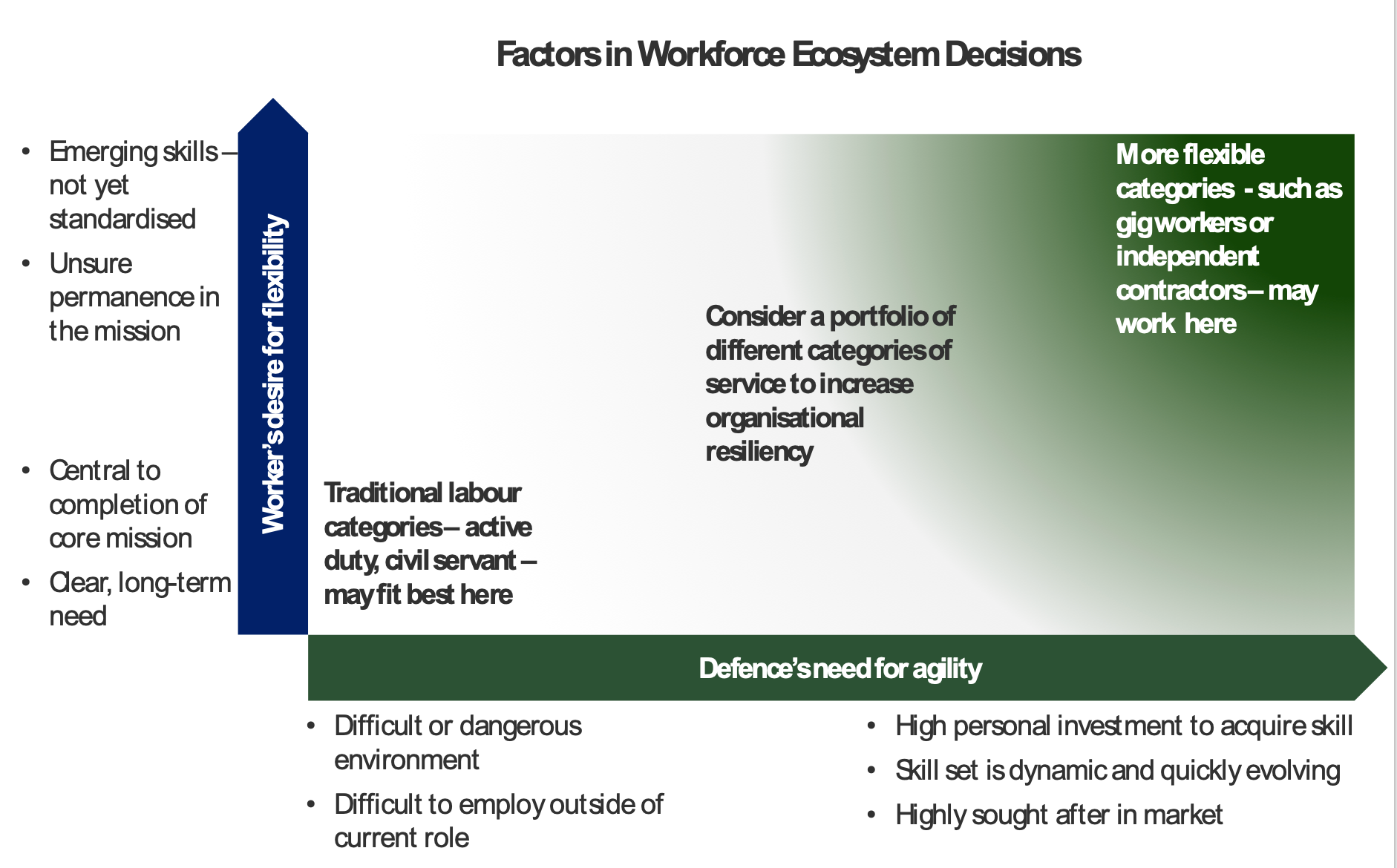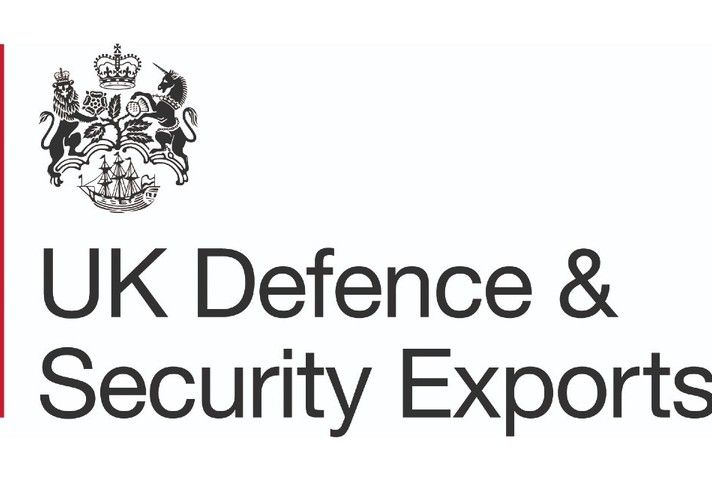
The UK MOD is facing unprecedented challenges in attracting, growing, and retaining the skills it needs to deliver its mission. The new systems and technologies that the UK is fielding add to this challenge, each requiring new skills, greater quantities of skills that are already in short supply, or both.
As the Defence Command Paper Revision describes the task, “we need to broaden our appeal to attract people with skills and experience acquired prior to joining and so we must look at our career structures and remuneration to reflect that not everyone joining Defence is doing so in their late teens or early twenties and in their first job”[i]. However, traditional models of incorporating new skills into the MOD will not be able to keep pace with the goals for fielding new systems, for a variety of reasons:
- MOD’s talent acquisition efforts are constrained to the precisely defined and inflexible categories of labour that have evolved over the MOD’s history. These categories make it difficult to respond to demand for new skills from within.
- These silos persist even after hiring, restricting MOD’s ability to apply skills where it needs them.
- The aptitude and flexibility needed to gain many of the needed skills are largely possessed by Millennial and Gen Z (and soon enough, Gen A) workers, who see flexibility as the most important employee factor for a business[ii].
- As pointed out in the recently released final report of the Haythornthwaite Review of Armed Forces Incentivisation, the traditional “base-fed model of recruitment is not well suited to the fast-moving and workforce-wide digital skills requirement.”[iii] The need for new skills emerge quickly, and defence cannot wait a generation to grow these new skills organically.
Defence is not exempt from the talent shortages impacting the global economy. Not only are the UK MOD and allied defence establishments suffering from the same labour shortages that are hurting many industries[iv]; but recruiting critical skills to defence is proving to be a difficult problem across multiple nations[v]
But there is an entire ecosystem of people with the right skills available if MOD can find the right way to unlock it.
What is the workforce ecosystem?
Essentially, using different workforce models – including non-traditional workers – strategically and flexibly to acquire and apply skills in the most efficient way. Unlocking the Workforce Ecosystem is one of the themes highlighted in Deloitte’s 2023 Global Human Capital Trends report, recognising how trends such as the rise of worker agency[vi], shortage of talent, generational preferences, need for increased agility, rise of digital technology, and the shift to skills-based organisations[vii] are driving public and private sector employers to make greater and more strategic use of non-traditional labour models[viii].
Like many other industries and organisations, Defence already makes use of an ecosystem to some degree. Within many elements of the MOD, you will find active duty serving personnel, reservists, civil servants, secondees, and contracted personnel from industry working to achieve mission goals. However, also like other industries, Defence has not yet taken the steps needed to fully unlock the value of the ecosystem[ix].
As identified in Deloitte’s report, the key is creating a unified workforce from the multiple models of the ecosystem. The report summarises the task:
“Finding better ways to integrate non-traditional workers into the workforce and culture will help give organizations expanded access to the crucial skills and talent necessary to thrive. It will also help unlock the full potential of that talent, while improving the organization’s ability to scale up and down or shift focus more rapidly in response to changes in the marketplace.”[x]
Though this will take effort, fully unlocking Defence’s workforce ecosystem can provide benefits across a broad set of workforce issues:
- It will give Defence additional flexibility in the way it accesses skills. An advantage in accelerating the adoption of new systems that require new skills. The continual changes in systems means that Defence must both be able to bring new skills aboard quickly and dismiss unneeded skills quickly – both require more flexibility than Defence has currently.
- More labour model choice will make a wider talent pool available to Defence by making Defence more attractive as a potential employer.
How do you do it?
Transitioning to a fully functioning workforce ecosystem will take effort. Fortunately, the UK MOD has already begun important foundational work. Other options that can unlock the workforce ecosystem include:
- Creating the infrastructure needed to manage by skills[xi] that will allow the organisation to see, in a model-agnostic way, the skills needed to accomplish a mission.
- Establishing the decision space by assessing which categories of service provide the most efficiency for each skills group. Emerging skills that do not yet have accepted standards are better acquired through the most flexible models, such as gig workers or consultants while skills that are key to the core mission of the organisation should be acquired under the long-term assumptions of traditional labour models. Making this a focused and intentional assessment is a critical success factor in the effort[xii].

- Understanding the workers’ perspective in different labour categories. If the skills require deep specialisation to acquire, the worker may not want the general organisational obligations that accompany traditional government employment. If a worker is going to apply the skills in a difficult or dangerous environment, the worker may want the assurances of long-term health, disability, and retirement benefits that are a part of military service. This forms the basis for a fair process for helping workers move to the category that both fits their needs and the organisations.
- Paying attention to inclusivity and equity and monitoring if the organisation tends to move more people of one gender or race into a particular model.
- Ensuring policies allow you to fully embrace and leverage workers from multiple models. This could include policy allowing flexibility in assigning among military, civilian, contractor, temporary, and gig workers. Other possibilities include alternative specialist career pathways and skills-based remuneration for military and civilian employees.
- This goes beyond just HR policy – commercial policy to make it easier to bring aboard independent contractors and ‘pool’ independent workers make these options more practical for defence organisations. As our research states: “Going forward, functional and business unit leaders need to work together to purposefully and systematically think about the holistic workforce ecosystem.”[xiii]
Like any major change in the defence workforce, it is important to have a strong understanding of the limitations, laws, and regulations that apply to each model[xiv]. Certain defence missions can only be accomplished by service personnel under the Law of Armed Conflict (see JSP 383), the UK’s Manual of Service Law (JSP 830), the US’s Uniformed Code of Military Justice (UCMJ), and other similar guidance. In addition, certain functions, particularly decision-making functions, must be done by a government employee (service personnel or civil servant)[xv]. Also, contract and temporary workers require different assessments around safety, liability, and reputational risks and work that is more sensitive from a security perspective may have to be done by highly vetted employees, which will tend toward more stable labour models.
Challenge: Pivot from Directing to Orchestrating
Even as an organisation makes the investments needed to complete the concrete steps above, it will take creative approaches to build a cohesive organisational culture when workers have different expectations and engagement to the organisation. It is what we call the “pivot from directing to orchestrating”[xvi].
A critical aspect of this challenge is the necessity to establish a ‘one team’ culture that includes workers from each model employed. Managing teams of people with different obligations and limitations will become increasingly the norm in every organisation. For example, for deployable military units, depending on model, some employees must deploy, some may deploy, and some can never deploy – yet all will still be needed for the mission[xvii]. Similarly, managers will have to carefully match the security requirements for tasks with workers who have different levels of vetting and monitoring.
The key is not to force managers to treat workers of various models the same[xviii]. In fact, those differences in treatment are part of the attraction of a robust workforce ecosystem for workers. The key is to create a common culture where all workers, regardless of labour model or skills profile, feel fully engaged with the organisation and understand their importance to the mission.
This requires a reorientation in how managers talk with and about their team – shifting the nexus of culture from formal organisational elements to a dedication to a shared mission. Leaders in MOD can begin the change by the way they identify their own roles and how they describe their work. As shared mission, rather than organisation, becomes the key focus of conversation, MOD will need to reinforce the re-conception with the way it identifies and rewards successful leaders.
Who has done it?
As mentioned before, public and private sector organisations across the globe are moving towards robust, fully unlocked workforce ecosystems. The UK MOD has reinforced the concept of the “Defence Nuclear Enterprise,” which considers strategic workforce planning and talent interventions across all workforce components dedicated to the Defence Nuclear mission including serving personnel in multiple front-line commands, civil servants, onsite contractor personnel, and personnel working for defence industry companies.
Among other public sector organisations, the US National Aeronautics and Space Administration (NASA) has invested heavily in building the infrastructure necessary to access the highly sought after and ever-evolving skills needed for its unique mission. Similarly, NASA used to have six talent-market platforms spread across multiple units, each of which independently matched employees with projects. Now the space agency uses a single talent marketplace — one orchestrating mechanism — to coordinate access to internal human talent across the organization. Their ultimate vision is “a more ‘porous border,’ where employees can spend a few years working for NASA on a particular project, and then later spend time at another commercial space organization.”[xix]
Taking next steps to include the external workforce in the overall mission at the corporate level, senior leaders at consumer products company Unilever are working to digitize data and insights about the external workforce as a prerequisite to upskilling external workers – estimated at 3 million - in addition to internal employees – circa 150,000 – to be able to fully and flexibly manage its entire workforce ecosystem[xx].
Value Waiting to be Unlocked
The premise behind this concept is an optimistic one for the UK MOD: The human capital that the MOD needs to fully leverage new systems and technology exists and is available, as long as the MOD employs the right approach to access it. However, that challenge is a significant one and will require leaders and managers in the MOD to adapt to new ways of employing skills and new ways of managing talent. The good news is many organisations across the world have been able to build that capacity to unlock their workforce ecosystems.
AUTHORS

Jim Turner - jimturner@deloitte.co.uk
Anna Brown - annabrown@deloitte.co.uk
Sam Taylor - samtaylor@deloitte.co.uk
[i] UK Ministry of Defence, “Defence’s response to a more contested and Volatile World,” “Chapter 1: Our People”, p.15, July 2023.
[ii] Deloitte Global, “A call for accountability and action: The Deloitte Global 2021 Millennial and Gen Z Survey”,2021.
[iii] Haythornthwaite, Rick, “Agency and Agility: Incentivising people in a new era. A review of UK Armed Forces incentivisation,” June 2023, Ministry of Defence, p. 64. Available at: Agency and Agility: Incentivising people in a new era - a review of UK Armed Forces incentivisation - GOV.UK (www.gov.uk)
[iv] See UK military recruiting statistics as listed in “UK defence personnel statistics,” UK Parliament, UK defence personnel statistics - House of Commons Library (parliament.uk) ,23 August 2022. Comparable issues in the US military are discussed in Jeremy Kofsky and Kael Weston, “The US military is losing recruits. Here’s how to change that,” The Boston Globe online, The US military is losing recruits. Here’s how to change that. (msn.com), 20 February 2023.
[v] Katerina Galai, Lucia Retter, Julia Muravska, Marta Kepe, Alice Lynch, Anna Knack, Jacopo Bellasio, (RAND Europe); Antonia Ward, Sofia Meranto & Davide Maistro, Fondazione Giacomo Brodolini: Liga Baltina & Terence Hogarth, “Defence-related skills: Building evidence on skills shortages, gaps and mismatches and defining the sector’s strategy on skills” European Defence Skills Partnership, January 2019 (EASME/COSME/2017/014).
[vi] For a discussion on how worker agency impacts defence organisations, see Jim Turner, “To Gain the Most from the Defence Workforce, Tap Into Their Agency”, 25th April 2023, To Gain the Most from the Defence Workforce, Tap Into Their Agency | Deloitte UK.
[vii] Similarly, for a discussion on how the transition from traditional to skills-based organisations in the British Army, see Sam Taylor, Anna Brown, and Sarah Buffham, “Defence workforce – harnessing the power of skills in the competitive age”, 24 August 2023, Defence Workforce – Harnessing the Power of Skills in a Contested and Volatile World. - DSEI 2023.
[viii] Sue Cantrell, Karen Weisz, Michael Griffiths, Kraig Eaton, “Unlocking the workforce ecosystem”, 9 January 2023, 2023 Global human capital trends | Deloitte Insights.
[ix] Ibid.
[x] Ibid.
[xi] Taylor, 24 August 2023.
[xii] As stated by Altman, Iron, Jones, Cantrell, Hatfield, and Ryder: “Intentional orchestrators are 5x more effective than non-orchestrators at aligning workforce needs with organization wide strategies.” Elizabeth J. Altman, David Kiron, Robin Jones, Susan Cantrell, Steven Hatfield, and Allison Ryder, “Intentionally Orchestrating Workforce Ecosystems,” MIT Sloan Management Review, 7 February 2023, Orchestrating Workforce Ecosystems: Strategically Managing Work Across and Beyond Organizational Boundaries (mit.edu).
[xiii] Cantrell, Weisz, Griffiths, Eaton, 9 January 2023.
[xiv] Ibid.
[xv] As an example, see the US’s Federal Acquisition Regulations (FAR) Subpart 7.5 “Inherently Governmental Functions”.
[xvi] Ibid.
[xvii] This concept is addressed in Chapter 2 of Haythornthwaite, June 2023, pp. 38-57.
[xviii] Cantrell, Weisz, Griffiths, Eaton, 9 January 2023.
[xix] Ogrysko, Nicole, “Hybrid work brings new professional development possibilities to NASA,” Federal News Network, 17 December 2021. Hybrid work brings new professional development possibilities to NASA | Federal News Network
[xx] Elizabeth J. Altman, David Kiron, Robin Jones, and Jeff Schwartz, “Orchestrating workforce ecosystems: Strategically managing work across and beyond organizational boundaries,” MIT Sloan Management Review, May 17, 2022.
© 2023 Deloitte LLP. All Rights Reserved. The contents of this article are confidential and the intellectual property of Deloitte LLP and may not be reproduced, redistributed or passed on to any other person in whole or in part without the prior written consent of Deloitte.
This publication contains general information only, and none of the Deloitte member firms are by means of this publication, rendering professional advice or services. Before making any decision or taking any action that may affect your business, you should consult a qualified professional adviser.
-
Latest Defence and Security Capabilities set to be on Display in London as DSEI 2023 Begins
12 Sep 2023Defence and Security Equipment International 2023 (DSEI) opened its doors Tuesday 12th September. DSEI 2023 and DSEI Connect will together host some 1,500 defence and security suppliers – including al ... -
KEY POINTS Rapid modernisation, innovation and technical development is needed for the UK to meet it’s twin priorities of protecting European allies, and stability in the Indo-Pacific. Using innovatio ...
-
DSEI 2023: Royal Navy To Set Up In Receive Mode, To Support Partnering Against Future Threats
04 Sep 2023 Dr Lee WillettThe UK Royal Navy (RN) will have significant presence at the DSEI 2023 exhibition, which is taking place at ExCeL London on 12-15 September. It is also seeking to grasp the engagement opportunity that ... -
Agile Acquisition & Rapid Delivery in Defence – Resilient Teams Harnessing Digital Means
04 Sep 2023“Technology is an extension of human behaviour” – a quote attributed variously, but traceable to the Canadian philosopher, Herbert Marshall McLuhan. Whilst originally referencing the study of media, t ... -
“Nobody ever stops or intervenes in a poor project soon enough. The temptation is always to ignore or under-report warning signs and give more time for things to improve to avoid revealing bad news, r ...
-
Understanding space: DSEI and UK Space Command
01 Sep 2023 John HillIn March this year, the European Space Agency (ESA) stressed the importance of space as a disruptive force in society and defence in its space strategy report, ‘Revolution Space’. “Countries… that wi ...

-038.jpg/fit-in/500x500/filters:no_upscale())
)
)
)
)
)

